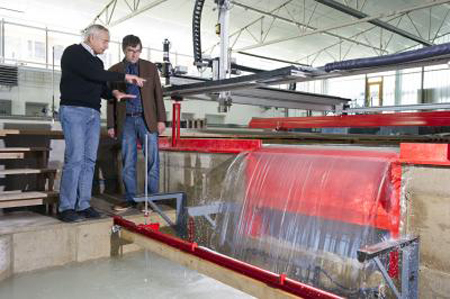One problem often cited as a major stumbling block to hydroelectric energy generated from dams is that they cause a huge environmental impact on the ecosystem of the river which has been dammed. Now a group of German researchers believe they’ve come up with a novel solution around this thorny issue which could make this form of renewable energy more acceptable – shrink the hydroelectric power plant to a very manageable size.
Researchers at Technische Universitaet Muenchen (TUM) in Germany have come up with a small scale hydroelectric power shaft plant design which they say solves a number of problems at the same time. Their approach reportedly “incurs very little impact on the landscape. Only a small transformer station is visible on the banks of the river. In place of a large power station building on the riverside, a shaft dug into the riverbed in front of the dam conceals most of the power generation system. The water flows into a box-shaped construction, drives the turbine, and is guided back into the river underneath the dam. This solution has become practical due to the fact that several manufacturers have developed generators that are capable of underwater operation – thereby dispensing with the need for a riverbank power house.”

As for how to protect fish, which is one of the most common environmental complaints around big dams, researchers cooked up what seems to be a simple solution: provide “a gate in the dam above the power plant shaft. In this way, enough water flows through to enable fish to pass.”
A model developed by the TUM team showcases what is said to be a number of usable ideas in creating similar setups, be it in industrialized nations or developing countries. These ideas include a cost effective design believed to be 30 and 50 percent lower by comparison with a bay-type hydropower plant; consideration of locations for the utilization of hydropower that had hardly been interesting before, such as areas with a low ‘head’ of water of only one to two meters; and, in the case of wider bodies of water, potential deployment of several shafts next to each other for greater power generation capacity.
“Major portions of the world’s population have no access to electricity at all,” said Professor Peter Rutschmann in a statement. “Distributed, local power generation by lower-cost, easy-to-operate, low-maintenance power plants is the only solution.”
Like what you are reading? Follow us on RSS, Twitter and Facebook to learn more and join the green technology discussion. Have a story idea or correction for this story you are reading? Drop us a line through our contact form.